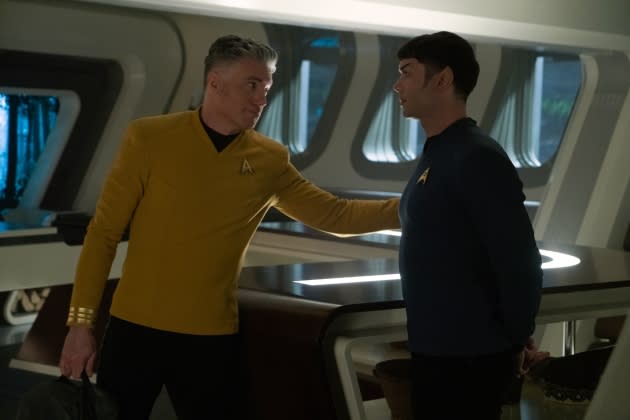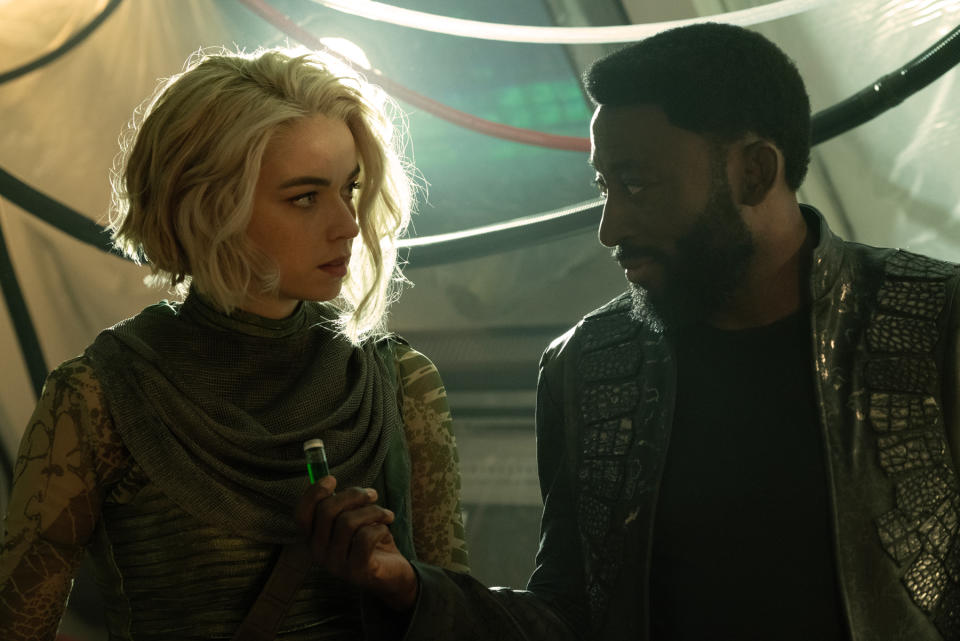‘Star Trek: Strange New Worlds’ Season 2 Is Remarkably Captivating
- Oops!Something went wrong.Please try again later.

We’ve been bingeing Star Trek: Deep Space Nine in my house lately. In addition to the underrated spinoff’s individual merits, it’s striking to be reminded of the differences between the era where every successful show made 20-plus episodes a year, and this current one, where 10 episodes per season is the most given to almost everybody, including modern-day Trek shows like Star Trek: Strange New Worlds.
There were definitely downsides to the old system. Unevenness was inevitable when producing that much content each season. As we near the midpoint of DS9, we’ve begun to just skip over all the episodes about the cartoonishly greedy Ferengi, for instance. And there are other incredibly thin installments that may as well open with one of the producers directly addressing the audience to say, “Look, we’re running out of ideas this year, but we had to come up with something, so … enjoy these fairy tales coming to life!” But the pros far outweighed the cons. The 22-episode approach allowed story and character arcs to play out more gradually, so that the payoffs would feel more satisfying. And it let both the audience and the creative team develop a deeper understanding of the characters, which often led to surprising new directions. What some modern viewers dismiss as “filler” episodes often turned out to be the most fun and/or important ones(*).
More from Rolling Stone
Tony Awards Livestream: Here's How to Watch the 2023 Tonys Online Free
This Paramount+ Summer Deal Gets You 50% Off A Subscription With Showtime
(*) My favorite example of this: “Red Team/Blue Team,” from late in the fourth season of The Good Wife. What was meant to be a self-contained palate cleanser between larger arcs — a mock trial pitting the firm’s senior partners against their less powerful associates — instead made the showrunners recognize that pitting their main characters against one another was even more interesting than bringing in guest stars as antagonists. This led to the series’ best creative stretch.
There’s not a lot of breathing room in the world of 10-episode (or less) seasons, especially since so many of them are strictly serialized. But Star Trek: Strange New Worlds — which returns for its second season this week — feels old-school not only because it’s set a few years before the events of the original Sixties series, and not only because it goes back to the Mission of the Week structure used so well in earlier franchise entries. Strange New Worlds also feels old-school because of how much it manages to pack into each installment, so that its shorter seasons can feel as rich and full as the strongest parts of The Next Generation and Deep Space Nine. It is, to borrow a famous Trek episode title, the best of both worlds.
The new season offers many different familiar Star Trek flavors. The premiere is largely action-oriented, as the young Spock (Ethan Peck) leads an Enterprise skeleton crew on a mission to prevent another war with the Klingons. Then there’s a courtroom episode, where first officer Una (Rebecca Romijn) is court-martialed for concealing that she comes from a race that uses genetic enhancements(*). That’s followed by a time-travel adventure pairing security chief La’an (Christina Chong) with a young James T. Kirk (Paul Wesley), then a thriller where the entire crew starts losing their memories while visiting a remote planet, another comedy episode about Spock’s complicated engagement to T’Pring (Gia Sandhu), and then a mystery where the young Uhura (Celia Rose Gooding) can’t tell if she’s communicating with a new alien race or simply going crazy.
(*) That one is also the biggest showcase yet for former Wynonna Earp star Melanie Scrofano as Captain Batel, the long-distance love interest of Anson Mount’s Captain Pike, and also a member of Starfleet’s JAG corps. It’s enough to make one wish for a spinoff focusing solely on Batel’s legal career. Law & Order: Starfleet, anyone?
All of these are executed at a very high level, and the variety is enough to please Trekkies of every stripe. (I have a particular soft spot for the comedy episodes, and Peck tends to be at his most self-assured in those.) But what’s most impressive is how well showrunners Henry Alonso Myers, Akiva Goldsman, and their team are able to keep digging deep into character and advancing various stories even within the confines of mostly non-serialized episodes. There’s the ongoing love triangle among Spock, T’Pring, and Jess Bush’s Nurse Chapel(*); Uhura growing more comfortable in Starfleet; La’an’s growing connection with Jim Kirk; the crew getting used to eccentric new chief engineer Pelia (Carol Kane); and more. The amnesia episode is primarily a Pike spotlight, yet it gives its biggest moment to Melissa Navia’s cocky pilot Erica Ortegas, while the Uhura episode is also Wesley’s best showcase as Kirk(**).

(*) Of all the characters from the original series who are part of the SNW ensemble (including Babs Olusanmokun as the gentle Dr. M’Benga), Chapel has gotten by far the biggest upgrade. The Sixties version was a two-dimensional character defined largely by a hopeless crush on Spock. Bush gets to play a bold scientific adventurer who just happens to like the half-Vulcan science officer, and whose feelings seem to be at least somewhat reciprocated.
(**) You don’t want any of these new actors to just do impressions of the Sixties cast. But there are times when Wesley’s take on Kirk has no resemblance beyond the name to the guy William Shatner played. (Or even the Chris Pine version.) And then there are others where he seems every bit as cocky as necessary. He’s still a recurring character, so there’s less time for Wesley to ease into the role than there is for Peck (who manages to evoke Spock without simply aping Leonard Nimoy), but it’s definitely among the season’s more erratic elements.
There are still limits to what Strange New Worlds can do within the space of so few episodes. Mount’s charismatic and kind Pike is the series’ most powerful tool, and his nearly superhuman level of empathy helps define every other character and relationship. But he’s barely in a couple of this season’s early episodes, and the amnesia story is the only one of the first six where Pike is clearly the central character. It’s tough to balance servicing the (very good) ensemble and the leading man in such a short season. Deep Space Nine has episodes where Avery Brooks’ Commander Sisko only appears briefly, but those stick out less because they’re surrounded by so many more that feature him prominently.
On the whole, though, it’s remarkable how much Strange New Worlds is able to accomplish in so little time. It helps that the episodes are 15-20 minutes longer than the Nineties shows got to deploy. Mostly, though, it’s that this creative team has a strong grasp on its crew, and on all the ways that Gene Roddenberry’s idealistic vision still feels relevant, necessary, and dramatically interesting almost 60 years later. In the court-martial episode, Una recalls observing a Starfleet crew in action when she was a little girl, and how it inspired her to conceal her true identity so she could enlist. “If all those people from all those worlds can work together side by side,” she recalls thinking, “maybe I can, too.”
It’s a lovely sentiment from a terrific show, which makes the most of the limited amount of time it’s given in the modern TV ecosystem.
The second season of Star Trek: Strange New Worlds debuts on June 15, with episodes releasing weekly. I’ve seen the first six.
Best of Rolling Stone

